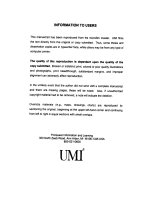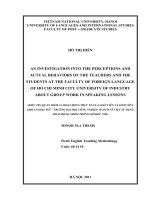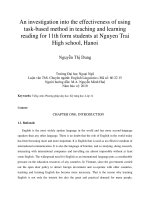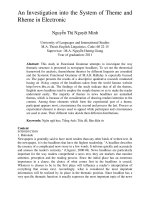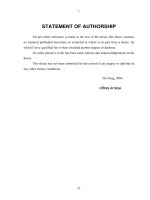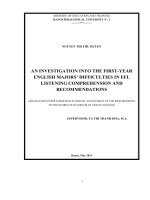An investigation into the syntactic and semantic features of verb phrases expressing victory and defeat in tennis commentaries in english and vietnamese
Bạn đang xem bản rút gọn của tài liệu. Xem và tải ngay bản đầy đủ của tài liệu tại đây (646.87 KB, 27 trang )
MINISTRY OF EDUCATION AND TRAINING
THE UNIVERSITY OF DANANG
BÙI THỊ NHUNG
AN INVESTIGATION INTO THE SYNTACTIC
AND SEMANTIC FEATURES OF VERB
PHRASES EXPRESSING VICTORY AND
DEFEAT IN TENNIS COMMENTARIES IN
ENGLISH AND VIETNAMESE
Major: English Linguistics
Code: 60.22.02.01
MASTER THESIS IN THE ENGLISH LANGUAGE
(Summary)
Da Nang, 2016
The thesis has been completed at
THE UNIVERSITY OF DANANG
Supervisor : Ngũ Thiện Hùng, Ph.D.
Examiner 1:
NGUYỄN QUANG NGOẠN, Ph.D.
Examiner 2:
TRẦN QUANG HẢI, Ph.D.
The thesis will be orally defended at The Examining Committee.
Field: English Linguistics
Time: 26/12/2016
Venue: The University of Da Nang
The thesis is accessible for the purpose of reference at:
- Information Resource Center, the University of Da Nang
- The Library of University of Foreign Language Studies,
The University of Da Nang
1
CHAPTER 1
INTRODUCTION
1.1. RATIONALE
Sports in particular have always been a common form of
entertainment. In the last decades, with the rise of television
broadcast with increasingly better filming technology, sports has
become commercialized, viewed by millions and a common form of
popular culture and tennis is one of those sports. It is also considered
by many to be the worlds. Thus, the role of the commentators is very
important. They have to provide commentary about the game and to
entertain at the same time. They have to deal with the unfolding
events on the pitch linguistically without hesitation. The nature of
their job and the unusual linguistic setting is what makes their speech
so specific. So how can they use the language to make their sports
commentaries interesting and attract the audiences as well as the
readers.
The following are some examples of Verb phrases expressing
victory and defeat in tennis commentaries in English:
(1.1) The world No1 came out against his Swiss opponent to
win his ten slam title over four thrilling sets to win his
10th Grand Slam title.
[1]
(1.2) Kerber kept pressing, and quickly forced three more
break points in Robson’s next service game only to be
denied again.
[2]
(1.3) The big Argentinian has crushed Stephane Robert 6-1, 75, 6-0.
[3]
And in Vietnamese:
2
(1.4) Novak Djokovic đánh bại Roger Federer sau 4 set (6-4,
5-7, 6-4, 6-4) để đăng quang chức vô địch US Open
2015.
[4]
(1.5) Dimitrov hạ gục Nadal ở tứ kết giải Trung Quốc mở
rộng.
[5]
(1.6) Ferrer đã chiến thắng trước tay vợt trẻ Alexander
Zverev (Nga, hạng 24 thế giới) với tỷ số 2-1 (6/7, 6/1,
7/5).
[6]
Such expressions ―came out on top against‖ seems to be
unfamiliar to the Vietnamese learners of English in terms of
cognitive view and linguistic structure.
The importance of using languages in sports commentaries
were concerned and analyzed by many linguists in Viet Nam and in
over the world, such as: Nguyen Thi Kieu Ngan (2011) [13] and Tran
Van Chanh (2011) [12]. However, none of their studies have
approached the issues of sport language from the view of cognitive
semantics and functional grammar. With the assumption that verbs of
this kind play an important role the language of sport commentaries, I
study the semantics of Verb phrases expressing victory and defeat in
perspectives of Cognitive semantics of Functional Grammar. I hope
that the Vietnamese learners of English will be able to further
understand about semantic functions of sport expressions of victory
and defeat in English and Vietnamese as well as avoid making errors
when using them.
From that reasons, I choose the topic for my proposal: “An
investigation into the syntactic and semantic features of Verb
phrases expressing victory and defeat in tennis commentaries in
English and Vietnamese”.
1.2. AIMS AND OBJECTIVES
3
1.2.1. Aims
This study aims to examine the syntactic and semantics features
of Verb phrases expressing victory and defeat in tennis commentaries.
The finding of the study is to help the Vietnamese learners of English
to have a better insight into these verbs and to be more aware of Verb
phrases used in tennis commentaries, propose some implications for
learning and teaching English as a foreign language
1.2.2. Objectives
With the aim mentioned above, this study is intended to:
- Describe the Verb phrases expressing victory and defeat in
tennis commentaries in terms of syntactic and sematic features in
English and Vietnamese
- Point out the similarities and differences of Verb phrases
expressing victory and defeat in tennis commentaries in term of
syntactic and semantic features in English and Vietnamese
- Offer some suggestions for the comprehending and
evaluation of Verb phrases expressing victory and defeat in tennis
commentaries
1.3. RESEARCH QUESTIONS
The study tried to find the answers to the following three
questions:
1. What are the syntactic features of Verb phrases expressing
victory and defeat in tennis commentaries in English and
Vietnamese?
2. What are the semantic features of Verb phrases expressing
victory and defeat in tennis commentaries in English and
Vietnamese?
3. What are the similarities and differences in terms of
syntactic and semantic features of Verb phrases expressing victory
4
and defeat in tennis commentaries in English and Vietnamese?
1.4. SCOPE OF THE STUDY
This study is confined to the syntactic and semantic features of
Verb phrases expressing victory and defeat in English and
Vietnamese which focus mainly on those used in tennis
commentaries through the analysis of data collection from tennis
newspapers and magazines in both English and Vietnamese.
1.5. THE SIGNIFICANCE OF THE STUDY
In this study, the researcher explores Verb phrases expressing
victory and defeat from tennis newspapers and then analyzes them in
terms of syntactic and semantic features to find out the similarities
and differences between the Verb phrases in each group of
expressing victory and defeat through clarifying their meanings and
syntactic functions.
This study is also expected to provide a better understanding of
how to use Verb phrases expressing victory and defeat in making
tennis commentaries with conceptual images which are more
interesting and attracting more and more readers, audiences and
viewers.
1.6. ORGANIZATION OF THE STUDY
Chapter One : Introduction
Chapter Two : Literature Review and Theoretical
Background
Chapter Three : Research Methods
Chapter Four : Findings and Discussion
Chapter Five : Conclusions
5
CHAPTER 2
LITERATURE REVIEW
AND THEORETICAL BACKGROUND
2.1. THE REVIEW OF PREVIOUS STUDIES RELATED TO
THE STUDY
Guranda focused on using Systemic Functional Grammar
approach describe the modal verb can semantically, syntactically and
to give a broad picture of the situation in the written and spoken
modern.
There also have been many researches done about Verb
phrases in Vietnam as well as in over the world: Nguyen Thi Kieu
Ngan (2011) [13], represented the sematic features of synonym used
in sports commentaries on football and their collocation. Tran Van
Chanh (2011) [12], mentioned about the Adjectives and their
collocations as Modifiers of Noun phrases in football commentaries
in English and Vietnamese. Tran Huu Thuan (2014) [14] shows the
differences between linguistic features of appreciation in football
commentaries in English and Vietnamese.
To sum up, all these studies were to a large extent a help to
make my choice of research topic. This paper represents an effort to
combine the best observations of the earlier studies with new results
of my research. There has not been a detailed analysis of Verb
phrases used in tennis commentaries in perspective of Functional
Grammar and Causation.
2.2. THEORETICAL BACKGROUND
2.2.1. Verb phrases
Verb phrases are headed to the extent that they are composed
of two kinds of element, auxiliaries and main verbs, such that every
6
unreduced verb phrase contains a main verb, but not necessarily an
auxiliary. Verb phrases consist of a main verb which either stands
alone as the entire verb phrase, or is preceded by up to four verbs in
an auxiliary function. (Table 2.1)
Moreover, Verb phrases generally are divides among two
types: finite verbs and non-finite verbs (such as: infinitive, participate
or gerund). Narrowly but Verb phrases can be defined as phrases
which are headed to the extent that they are composed of two kinds
of element, auxiliaries and main verbs, such that every unreduced
verb phrase contains a main verb, but not necessarily an auxiliary.
2.2.2. Verb phrase in view of Clause as Exchange in
Functional Grammar
a. The Mood Element
According to Halliday (1985) [1], Mood consists of two parts:
(1) the Subject, which is a nominal group, and (2) the Finite element,
which is part of a verbal group. The Subject may be any nominal
group. The Finite element is one of a small number of verbal
operators expressing tense or modality. However, in some instances
the Finite element and the lexical verb are ‗fused‘ into a single word,.
b. The Residue
In Halliday‘s views (1985) [1], the Residue consists of
functional elements of three kinds: Predicator, Complement and
Adjunct. There can be only one Predicator, one or two complements,
and an indefinite number of Adjuncts. The Predicator is present in all
non – elliptical major clauses, apart from certain clauses with verbs
be and have. It is realized by a verbal group minus the temporal or
modal operator, which as we have seen functions as Finite in the
Mood element.
7
2.2.3. Verb phrase in view of Clause as Representation in
Functional Grammar
In English, there are a few processes, like raining, which are left
unanalyzed; but more typically the English language structures each
experience as a semantic configuration on the principle illustrated
above, consisting of process, participants and circumstantial elements.
One way of looking at the situation is this; the process is the most
central element in the configuration. Participants are close to the
center; they are directly involved in the process, bringing about its
occurrence or being affected by it in some way. And we can say that
the configuration of process + participants constitutes the experiential
center of the clause. Circumstantial elements augment this center in
some way - temporally, spatially, causally and so on; but their status in
the configuration is more peripheral and unlike participants they are
not directly involved in the process.
- Material processes: processes of doing and happening
The ‗material‘ clauses construe the procedure as a sequence of
concrete changes in the trees brought about by the person being
instructed - the implicit ‗you‘. In ‗material‘ clauses in general, the
source of the energy bringing about the change is typically a
participant - the Actor.
- Intransitive
In a ‗material‘ clause, there is always one participant — the
Actor. This participant brings about the unfolding of the process
through time, leading to an outcome that is different from the initial
phase of the unfolding. This outcome may be confined to the Actor
itself, in which case there is only one participant inherent in the
process. Such a ‗material‘ clause represents a happening and, using
traditional terminology, we can call it intransitive.
8
- Transitive
The unfolding of the process may extend to another participant,
the Goal, impacting it in some way: the outcome is registered on the
Goal in the first instance, rather than on the Actor. Such a ‗material‘
clause represents a doing and we can call it transitive.
2.3. SUMMARY
In summary, chapter two of this paper presents previous
studies related to the research. It has given out the general
introduction about tennis commentaries in English and Vietnamese.
Besides, the theoretical background is a very necessary source of
knowledge to provide readers for the first insight into understanding
thoroughly what were discussed in this paper. The concepts of verbs,
verb phrases, .the classification of verbs expressing victory and
defeat in English and Vietnamese were revealed. What is more, the
syntactic features of verb phrases in view of Clause as Exchange and
semantic features of verb phrases in view of Clause as Representation
in Functional Grammar were mentioned as a basic foundation for the
investigation in this study.
CHAPTER 3
RESEARCH METHODS
3.1. RESEACH DESIGN
In order to make a study on language manipulation in the
sports commentaries, both qualitative and quantitative research
design were resorted to the study
3.2. RESEARCH METHODS
As mentioned above, the qualitative and quantitative designs
were used to find out the semantic features of the Verb phrases.
9
Descriptive method was used in order to give a detailed description
of the syntactic and semantic features of Verb phrases with
quantitative and qualitative information. The methods and techniques
for collecting the qualitative and quantitative data was observation of
the instances of samples of Verb phrases in the tennis commentaries
3.3. DATA COLLECTION
3.3.1. Sampling of Study
3.3.2. Instrument
3.4. DATA ANALYSIS
3.5. RESEARCH PROCEDURES
3.6. RELIABLITY AND VALIDITY
3.7. SUMMARY
This chapter presents research methodology and the ways to
get samples, instrumentation and procedure of the data collection.
Additionally, how to make data reliable and valid in the thesis are
also mentioned in this chapter.
CHAPTER 4
FINDINGS AND DISCUSSION
4.1. SYNTACTIC FEATURES OF VERB PHRASES
EXPRESSING VICTORY AND DEFEAT IN TENNIS
COMMENTARIES IN ENGLISH AND VIETNAMESE
4.1.1. The Syntactic Features of English Verb Phrases of
Victory and Defeat in view of Clause as Exchange
In this section, we analyzed the Verb phrases in tennis
commentaries in view of clause of exchange. The verb phrase is
organized in Mood and Residue. The Mood consists of two parts: (1)
the Subject, which is a nominal group, and (2) the Finite element,
10
which is part of a verbal group. The Residue consists of functional
elements of three kinds: Predicator, Complement and Adjunct. There
can be only one Predicator, one or two complements, and an indefinite
number of Adjuncts. Let‘s consider to the non-finite clauses which
contains a Predicator but no Finite element
MODEL 2:
SUBJECT PREDICATOR ADJUNCT
(4.34) Nadal triumphed at Masters in Madrid 6.
[48]
Nadal
at Masters in Madrid 6
triumphed
Subject
Finite
Predicator
Adjunct
Mood
Residue
Figure 4.1. Subject, Predicator and Adjunct in English
In this example, we have two elements: the Mood and the
Residue. The Mood consists of two parts: the Subject ―Nadal‖ and
Finite: the verb is in simple past, positive, neutral, active. The
Residue consists of functional elements of two kinds: Predicator
―triumph‖ and Adjunct ―at Masters in Madrid 6‖. The verb
triumph is intransitive.
MODEL 4:
SUBJECT PREDICATOR COMPLEMENT ADJUNCT
(4.37) Williams beats Kerber in straight sets.
[60]
Williams
Kerber
in straight
beats
sets
Subject
Finite
Predicator Complement Adjunct
Mood
Residue
Figure 4.4. Subject, Predicator, Complement and Adjunct in English
In this example, we have the Mood and the Residue. The
Mood consists of two parts: the Subject ―Williams‖ and Finite: the
verb is in simple present, positive, neutral, active. The Residue
consists of functional elements of three kinds: Predicator ―beats‖,
11
Complement ―Kerber‖ and Adjunct ―in straight sets‖. The Predicator
beat in this sentence is transitive.
The following Models, we will consider to the Verb phrases
which containing a Predicator and Finite elements.
MODEL 8:
SUBJECT FINITE PREDICATOR ADJUNCT
(4.44) Verdasco has won the fourth set 6-3.
[51]
Verdasco
the fourth set 6-3
has
won
Subject
Finite
Predicator
Adjunct
Mood
Residue
Figure 4.11. Subject, Finite, Predicator and Adjunct in English
In this example, we have the Mood and the Residue. The
Mood consists of two parts: the Subject ―Verdasco‖ and the Finite
―has‖. The Residue consists of functional elements of two kinds:
Predicator ―won‖ and Adjunct ―the fourth set 6-3‖. The Finite has is
Primary Tense. It follows after Subject Verdasco and before the
Predicator won. The Predicator won in this sentence is intransitive.
MODEL 9:
SUBJECT FINITE PREDICATOR COMPLEMENT ADJUNCT
(4.46) Thiem has trounced Adrian Mannarino 6-1, 6-3 in the
round of 4.
[59]
Thiem
has
trounced
in state
opener
Complement Adjunct
Sonoraville
tennis
Subject
Finite Predicator
Mood
Residue
Figure 4.13. Subject, Finite, Predicator, Complement and Adjunct in
English
12
In this example, we have the Mood and the Residue. The
Mood consists of two parts: the Subject ―Thiem‖ and the Finite
―has‖. The Residue consists of functional elements of three kinds:
Predicator ―trounce‖, Complement ―Sonoraville‖ and Adjunct ―the
fourth set 6-3‖. The verb trounce in this sentence is transitive.
In these examples which contain both Finite has, have, had and
Predicator won, shocked, trounced, thrashed, ousted, edged and
beaten we can see that the Finite are in the sense of possess,
expressing the present perfect tense: has, have and past perfect tense
had. The Predicators are transitive: beat, edge, thrash, oust and
intransitive: win. In conclusion, both finite and non-finite verb
phrases have transitive and intransitive. We can see at the table 4.5.
4.1.2. The Syntactic Features of Vietnamese Verb Phrases
of Victory and Defeat in view of Clause as Exchange
Let‘s consider some Vietnamese examples with non-finite
MODEL 2:
SUBJECT PREDICATOR ADJUNCT
(4.51) Nadal chiến thắng dễ dàng trong set quyết định. [54]
Nadal
trong set quyết định
chiến thắng dễ dàng
Subject
Finite Predicator
Comment Adjunct
Adjunct
Mood
Residue
Figure 4.18. Subject, Predicator and Adjunct in Vietnamese
In this example, we have the Mood and the Residue. The
Mood consists of two parts: Subject ―Thiem‖ and Finite: the verb is
in simple present, active, positive and neutral. The Residue consists
of functional elements of two kinds: Predicator ―chiến thắng‖ and
Adjunct ―trong set quyết định‖. The verb ―chiến thắng‖ in this
13
sentence is intransitive.
MODEL 4:
SUBJECT PREDICATOR COMPLEMENT ADJUNCT
(4.53) Murray nghiền nát Chardy ở tứ kết.
[73]
Murray
ở tứ kết
nghiền nát Chardy
Subject
Finite
Predicator
Complement Adjunct
Mood
Residue
Figure 4.20. Subject, Predicator, Complement and Adjunct in
Vietnamese
From this example, we can see that there are two elements: the
Mood and the Residue. The Mood consists of: Subject ―Murray‖ and
Finite: the verb is in simple present, active, positive and neutral. The
Residue consists of functional elements of three kinds: Predicator
―nghiền nát” Complement ―Chardy‖ and Adjunct ―ở tứ kết‖. The
verb nghiền nát is Transitive.
MODEL 8:
SUBJECT FINITE PREDICATOR COMPLEMENT ADJUNCT
(4.61)Murray đã khuất phục đối phương với tỷ số 7-4. [76]
Murray
đã
với tỷ số 7khuất phục đối phương
4
Subject
Finite Predicator
Complement
Adjunct
Mood
Residue
Figure 4.28. Adjunct, Finite, Subject, Predicator, Adjunct,
Complement and Adjunct in Vietnamese
From this example, we can see that there are two elements: the
Mood and the Residue. The Mood consists of: Subject ―Murray‖,
Finite ―đã‖ is in simple past, active, positive and neutral. The Residue
consists of functional elements of three kinds: Predicator ―khuất
phục‖, Complement ―đối phương‖ and Adjunct ―với tỷ số 7-4. The
Verb khuất phục is transitive.
14
4.1.3. Remarks on Similarities and Differences of Verb Phrases
Expressing Victory and Defeat in English and Vietnamese in
terms of Syntactic Features
To put statistics for verb phrases expressing victory and defeat
used in English and Vietnamese tennis commentaries in comparison
and contrast in term of syntactic features, some findings can be
observed.
a. Similarities
As seen from the figures in the parts of verb phrases
expressing victory and defeat in English in terms of syntactic
features, both English and Vietnamese verb phrases have a variety of
from. In view of Clause as Exchange, there are two parts in the
sentences: the Mood and the Residue. The Mood consists of Subject
Finite. The Residue consists of functional elements of three kinds:
Predicator, Complement and Adjunct. For examples, in transitive
structure: ATP World Tour Finals: Djokovic edged Raonic in two tie
breaks in English and Nadal đánh bại Federer trong trận "siêu kinh
điển" làng Tennis. In this example, the Mood consists of Subject
Djokovic and Nadal, there is not Finite element. The Residue consists
of Predicator edged, đánh bại; Complement Raonic, Federer and
Adjunct in two tie breaks, trong trận "siêu kinh điển" làng Tennis
b. Differences
A distinguished feature of Vietnamese verb phrases is that:
there is the explicitness of finite in English. However in Vietnamese,
the finite is suppressed. For examples:
One more interesting point out the differences between English
and Vietnamese verb phrases. In English, almost of verb phrases
consists of one morpheme, such as: crash, edge, win,… same as
Vietnamese verb phrases thắng, loại,… In English, we can use
15
derived verbs which combine from two morphemes, such as: up+set,
de+feat while in Vietnamese we use Phrasal verbs from two
morphemes/ words, such as: chiến + thắng, đánh + bại, nghiền +
nát, lật + đổ, hạ + gục, làm + gỏi
4.1.4. Summary
In conclusion, this part compares the verb phrase expressing
victory and defeat in English and Vietnamese in term of syntactic
features and view of Clause as Exchange in Functional Grammar.
There are some similarities and differences as I mention above.
4.2. SEMANTIC FEATURES OF VERB PHRASES
EXPRESSING VICTORY AND DEFEAT IN TENNIS
COMMENTARIES IN ENGLISH AND VIETNAMESE
4.2.1. Clause as Representation
In this section, we analyzed the Verb phrases express victory
and defeat in view of clause of representation. The basic semantic
framework for the representation of processes is very simple. A
process consists potentially of three components: the process itself,
participants in the process and circumstances associated with the
process. These provide the frame of reference of interpreting our
experience of what goes on.
English examples:
MODEL 1:
PARTICIPANT PROCESS CIRCUMSTANCE
(4.66) Nadal triumphed at Masters in Madrid 6.
[8]
Nadal
at Masters in Madrid
triumphed
6
Actor
Process:
Material: Circumstance:
action
Location: temporal
16
Nominal group: the Verbal group
Thing:
personal
pronoun
Prepositional phrase
Figure 4.33. Actor, Process and Circumstance in English
There are three elements in this sentence: Participant: Actor
―Nadal‖, Process: Material: action ―triumphed” and Circumstances:
Location: temporal ―at Masters in Madrid 6‖. Participant is a
Nominal group: the Thing: personal pronoun; Process is a Verbal
Group and Circumstance is a Prepositional phrase. The Verb
triumph in this example is Intransitive.
MODEL 2:
PARTICIPANT PROCESS PARTICIPANT CIRCUMSTANCE
(4.69) Williams beats Kerber in straight sets.
Williams
beats
Kerber
Actor
Process: Goal
Material:
action
[11]
in straight sets
Circumstance:
Location:
temporal
Nominal group: the Verbal
Nominal group: Prepositional
Thing:
personal: group
the
Thing: phrase
pronoun
personal: pronoun
Figure 4.36. Actor, Process, Goal and Circumstance in English
Vietnamese examples:
MODEL 1:
PARTICIPANT PROCESS CIRCUMSTANCE
(4.80) Nadal chiến thắng dễ dàng trong set quyết định. [54]
17
chiến
thắng
Actor
Process:
Material:
action
Nominal group: Verbal
the
Thing: group
personal: pronoun
Nadal
dễ dàng
Circumstance:
Manner:
quality
Adverbial
Group
trong
set
quyết định
Circumstance:
Location:
temporal
Prepositional
phrase
Figure 4.47. Circumstance, Actor, Process, Goal and Circumstance
in Vietnamese
MODEL 2:
PARTICIPANT PROCESS PARTICIPANT CIRCUMSTANCE
(4.81) Murray nghiền nát Chardy ở tứ kết.
[73]
Murray
nghiền nát
Chardy
ở tứ kết
Actor
Process:
Goal
Circumstance:
Material:
Location: Spatial
action
Nominal
Verbal group Nominal
Prepositional
group:
the
group: the
phrase
Thing:
Thing:
personal:
personal:
pronoun
pronoun
Figure 4.42. Circumstance, Actor, Process, Goal and Circumstance
in Vietnamese
4.2.2. Analysis of the Semantic Fields of some Verb Phrases
Expressing Victory and Defeat in English and Vietnamese in
term of Causativity
There are some causative verbs mentioned in the chapter 4.2
above such as: Defeat, Beat, Conquer, Trounce, Thrash, Crush,
18
Knock out, Hammer, Upset, Crash . The causative verbs in tables 4..
can be used in the modelized pattern as a typical lexical causative
construction X VCAUSATIVE Y. At first look, the pattern X VCAUSATIVE
Y implies a natural activity which suggests little about the success of
causation as well as the interaction between the causer and causee.
In Vietnamese causative verbs like: đánh bại hoàn toàn, đánh
cho thua tơi bời in (61), (59) and (63) and nghiền nát in (3) encode
the two semantic parts: causing verb and resulting verb. The resulting
verb may be an action or a state depending on the meanings of the
Vietnamese translational equivalents.
However, there are some Vietnamese causative verbs
expressed with the analytic causative construction X VCAUSATIVE Y
VRESULT. Table 4.23b below will show the construction
Semantically, with analytic causative constructions, X has the
semantic properties of a subject, the role which is most relevant to
the success of the activity. Analytic constructions relate the subject of
complement clause to impedance of the success of the activity.
In the lexical causative type, the subject agent as causer
receives the focus as a default case whereas in the analytic type, the
focus may be shifted to the subject agent as the causee. This is
explicated in the result where the causee is understood as the
performer of the action or state.
4.2.3. Remarks on Similarities and Differences of Verb
Phrases Expressing Victory and Defeat in English and
Vietnamese in terms of Semantic Features
a. Similarities
Semantically, English and Vietnamese verb phrases expressing
victory and defeat have the following common semantic features:
In a clause of material process, there is one participant, who is
19
human, this is actor; the one that does something and process. This
happen in intransitivity structure, for examples: In English: Federer
wins the first two points of the tie break. In Vietnamese: Nadal chiến
thắng dễ dàng trong set quyết định. From these examples, we can see
that: there is one participant – the Actor Federer, Nadal realized by
Nominal group. Material process wins, chiến thắng and Circumstanc
the first two points of the tie break, dễ dàng trong set quyết định
realized by a nominal group.
In a clause of material, there are two participants, the Actor
and the Goal, This is more popular and this happen in transitivity
structure, for examples in English Novak Djokovic has edged Julien
Benneteau at the Rogers Cup and in Vietnamese Murray lật đổ
Djokovic tại Rogers Cup. From these examples, we can see that:
there are two participants – the Actor Novak Djokovic, Murray
realized by Nominal group. Material process has edged, lật đổ and
Goal Julien Benneteau, Djokovic and Circumstanc the first two
points of the tie break, dễ dàng trong set quyết định realized by a
nominal group at the Rogers Cup, tại Rogers Cup.
b. Differences
Apart from the above similarities, the study also point out
some considerable differences between verb phrases expressing
victory and defeat in English and Vietnamese.
With respect to semantic features, the differences about
Causality can show that:In English, causative process and causative
result are encoded in one verb phrase crash. However in Vietnamese,
the meanings of verb phrases are encoded into: nghiền (causative
process) + nát (causative result). Examples:
(4.96) Trận đấu cuối cùng: Clijsters đánh bại Venus
Williams 2.
[82]
20
(4.97) Murray nghiền nát Chardy ở tứ kết.
Causative
Causative
Causer
Causee
process
Result
Clijsters
Murray
đánh
nghiền
bại
nát
[46]
Venus Williams 2
Chardy
Figure 4.61. Causer, Causative process, Causative Result and
Causee in Vietnamese
However, in English the causative process and causative result
can be expressed in one verb phrase, examples:
(4.98) The big Argentinian has crushed Stephane Robert 61, 7-5, 6-0.
[27]
Semantic
function
Causative Causative
Causer
Causee
process
result
Contrastive
language
The big
has crushed
Stephane
English
Argentinian
Robert
Anh chàng
Stephane
Vietnamese
Achentina đã nghiền
nát
Robert
khổng lồ
Figure 4.62. Causer, Causative process, Causative Result and
Causee in English versus Vietnamese
From the examples, we can see that in English the causative
verbs are made of three main elements: causer – process – causee in
which the process is realized by only one verb form: causing verb
crush,. However, in Vietnamese, the process of causative verbs
encodes the two semantic parts: causing verb and resulting verb, such
as: causing verbs đã nghiền and resulting verbs nát.
21
4.3. SUMMARY
In this chapter, English and Vietnamese verb phrases
expressing victory and defeat were introduced, discussed and
analyzed to find out the similarities and differences in terms of
syntax and semantic. A lot of data from Vietnamese and English
source were used for comprehensive observation of using these
verbs. In order to solve the problem, I would like to offer some
implications which will be presented in detail in chapter five.
CHAPTER 5
CONCLUSIONS
From the result presented in the foregoing chapter about the
syntactic and semantic features of Verb phrases in the tennis
commentaries, this chapter summarizes the main finding as
conclusions and provides some implications and suggestions for
English learners.
5.1. CONCLUSIONS
Through the result of data collection and data analysis of
English and Vietnamese verb phrases expressing victory and defeat
in tennis commentaries, the following are what the study has reached:
With respect to the syntactic features, the study has
demonstrated the ability of verb phrases expressing victory and
defeat in English and Vietnamese. Most of them (predicators) are
transitive; they combine with nouns (complement) in finite clause. In
this clause as seen from the figures in the parts of verb phrases
expressing victory and defeat in English in terms of syntactic
features, both English and Vietnamese verb phrases have a variety of
from. In view of Clause as Exchange, there are two parts in the
22
sentences: the Mood and the Residue. The Mood consists of Subject
and Finite. The Residue consists of functional elements of three
kinds: Predicator, Complement and Adjunct. A distinguished feature
of Vietnamese verb phrases is that: there is the explicitness of finite
in English. However in Vietnamese, the finite is suppressed. About
the differences, verb phrases in English consists of one morpheme,
such as: crash, edge, win,… same as Vietnamese verb phrases thắng,
loại,… However, in English we can use derived verbs which
combine from two morphemes, such as: up+set, de+feat while in
Vietnamese we use Phrasal verbs from two morphemes/ words, such
as: chiến + thắng, đánh + bại, nghiền + nát, lật + đổ, hạ + gục, làm
+ gỏi.
From the semantic analysis of the examples taken from
English and Vietnamese tennis commentaries, we can come to the
conclusion that the differences in the meanings of verb phrases
expressing victory and defeat are not remarkable. They express
material process of winning In a clause of material process, there is
one participant, who is human, this is actor; the one that does
something and process. This happens in intransitivity structure. In a
clause of material, there are two participants, the Actor and the Goal
then the process. This happens in transitivity structure.
In the view of Causative meaning, the English causative verbs
are made of three main elements: causer – process – causee in which
the process is realized by only one verb form: causing verb.
However, in Vietnamese, the process of causative verbs encodes the
two semantic parts: causing verb and resulting verb. For instance,
process crush is realized by only one verb phrase causing verb crush in English, however it encodes the two semantic parts: causing
verb nghiền and resulting verb nát in Vietnamese.
23
5.2. IMPLICATIONS
In order to help Vietnamese learners of English learn and use
verb phrases expressing victory and defeat effectively, some
suggestions for language learning and teaching are put forward:
5.2.1. To the Learners
When reading and translating the tennis commentaries,
Vietnamese learners should be aware of the similarities and
differences of verb phrases expressing victory and defeat between
two languages in terms of syntactic and semantic features. This is
very important for promoting positive transfer, and minimizing
negative transfer. In detail, when making sentences, the learners
should impose the use of their mother tongue to interpret the target
one without paying much attention to the differences in syntactic
features between the two languages. As a result, syntactic mistakes
are unavoidable.
Then, understanding and distinguishing the meanings of each
verb is necessary. Learners of English just look for the verb phrases
without caring about their distinctive semantic features, which
prevents them from expressing their ideas effectively. Especially in
translating sentences with the occurrence of causativity, some
important factors should be taken into consideration. The knowledge
of English and Vietnamese causative constructions such as lexica and
analytic constructions as well as the difference in encoding causative
verbs such as ―causative verb‖ and ―resulting verb‖ should be
emphasized. Therefore, students should be equipped with wellrounded knowledge in relation to the use of verb phrases expressing
victory and defeat so that they can convey the greatest amount of
comprehensive information to readers and select suitable English or
Vietnamese translational equivalents in different contexts. They can
decide the best words choice when translating to make the
commentaries more interesting.
